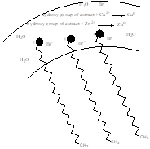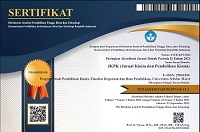
Synthesis, Characterization, and Antibacterial Activity of ZnO-CuO Nanoparticles Embedded in Chitosan and Polyvinyl Alcohol as Supporting Materials
Abstract
The biosynthesis of bimetallic metal nanoparticles (ZnO–CuO) and their interaction with chitosan and polyvinyl alcohol (PVA) have garnered significant attention in recent years, primarily due to their promising antibacterial applications. This work proposes the bio-fabrication of ZnO–CuO nanoparticles, chitosan–PVA–ZnO–CuO nanoparticle films, and reports their physicochemical and antibacterial potential. Green betel leaves (Piper betle L.) ethanol extract was used to synthesize ZnO–CuO nanoparticles. For as-prepared bimetallic NPs, chitosan (CS), PVA, and bimetallic NPs-based films were fabricated using the casting technique. The films were investigated by Fourier Transform Infrared (FT-IR) spectroscopy, X-ray Diffraction (XRD), Scanning Electron Microscopy (SEM), and the antibacterial activity was evaluated by the agar diffusion method. FT-IR measurements showed the presence of Zn–O and Cu–O functional groups at 396 cm⁻¹ and 418 cm⁻¹ in the nanoparticles, and the films A, B, and C, these bands were observed at 394–395 cm⁻¹ (Zn–O) and 409–416 cm⁻¹ (Cu–O). Crystallite sizes of ZnO, CuO, and ZnO–CuO NPs were 4.845 nm, 54.143 nm, and 5.306 nm, respectively. SEM examination showed that the surface of the films was rough and not homogeneous. Antibacterial experiments revealed the better inhibitory activity of film C than film A and film B. The advantage of the antibacterial property was attributed to the reactive oxygen species (ROS) generated by the ZnO–CuO in collaboration with chitosan. These results indicate that chitosan/PVA film loaded with ZnO–CuO NPs holds great promise as an effective antibacterial packaging material.
Keywords
Full Text:
PDFReferences
[1] M. A. Reyes-Torres et al., “Synthesis of CuO and ZnO nanoparticles by a novel green route: Antimicrobial activity, cytotoxic effects and their synergism with ampicillin,” Ceram. Int., vol. 45, no. 18, pp. 24461–24468, 2019, doi: 10.1016/j.ceramint.2019.08.171.
[2] B. Kumar, K. Smita, L. Cumbal, A. Debut, and Y. Angulo, “Biofabrication of copper oxide nanoparticles using Andean blackberry (Rubus glaucus Benth.) fruit and leaf,” J. Saudi Chem. Soc., vol. 21, pp. S475–S480, 2017, doi: 10.1016/j.jscs.2015.01.009.
[3] T. Jan et al., “Superior antibacterial activity of ZnO-CuO nanocomposite synthesized by a chemical Co-precipitation approach,” Microb. Pathog., vol. 134, no. December 2018, p. 103579, 2019, doi: 10.1016/j.micpath.2019.103579.
[4] E. Takele, R. Feyisa Bogale, G. Shumi, and G. Kenasa, “Green Synthesis, Characterization, and Antibacterial Activity of CuO/ZnO Nanocomposite Using Zingiber officinale Rhizome Extract,” J. Chem., vol. 2023, 2023, doi: 10.1155/2023/3481389.
[5] S. Kumari et al., “A comprehensive review on various techniques used for synthesizing nanoparticles,” J. Mater. Res. Technol., vol. 27, pp. 1739–1763, 2023, doi: 10.1016/j.jmrt.2023.09.291.
[6] Y. Cao et al., “Green synthesis of bimetallic ZnO–CuO nanoparticles and their cytotoxicity properties,” Sci. Rep., vol. 11, no. 1, pp. 1–8, 2021, doi: 10.1038/s41598-021-02937-1.
[7] L. Heliawati, S. Lestari, U. Hasanah, D. Ajiati, and D. Kurnia, “Phytochemical Profile of Antibacterial Agents from Red Betel Leaf (Piper crocatum Ruiz and Pav) against Bacteria in Dental Caries,” Molecules, vol. 27, no. 9, 2022, doi: 10.3390/molecules27092861.
[8] G. Marslin et al., “Secondary metabolites in the green synthesis of metallic nanoparticles,” Materials (Basel)., vol. 11, no. 6, pp. 1–25, 2018, doi: 10.3390/ma11060940.
[9] K. Nakata, T. Tsuchido, and Y. Matsumura, “Antimicrobial cationic surfactant, cetyltrimethylammonium bromide, induces superoxide stress in Escherichia coli cells,” J. Appl. Microbiol., vol. 110, no. 2, pp. 568–579, 2011, doi: 10.1111/j.1365-2672.2010.04912.x.
[10] M. Shirzad-Siboni, A. Khataee, A. Hassani, and S. Karaca, “Preparation, characterization and application of a CTAB-modified nanoclay for the adsorption of an herbicide from aqueous solutions: Kinetic and equilibrium studies,” Comptes Rendus Chim., vol. 18, no. 2, pp. 204–214, 2015, doi: 10.1016/j.crci.2014.06.004.
[11] E. T. Wahyuni, R. Roto, F. A. Nissah, Mudasir, and N. H. Aprilita, “Modified silica adsorbent from volcanic ash for Cr(VI) anionic removal,” Indones. J. Chem., vol. 18, no. 3, pp. 428–433, 2018, doi: 10.22146/ijc.26905.
[12] M. A. Akl, A. G. Mostafa, M. Y. Abdelaal, and M. A. K. Nour, “Surfactant supported chitosan for efficient removal of Cr(VI) and anionic food stuff dyes from aquatic solutions,” Sci. Rep., vol. 13, no. 1, pp. 1–27, 2023, doi: 10.1038/s41598-023-43034-9.
[13] A. Fatoni et al., “The Film of Chitosan-ZnO Nanoparticles-CTAB: Synthesis, Characterization and In Vitro Study,” Sci. Technol. Indones., vol. 7, no. 1, pp. 58–66, 2022, doi: 10.26554/sti.2022.7.1.58-66.
[14] D. Geetha and T. Thilagavathi, “Hydrothermal synthesis of nano ZnO structures from CTAB,” Dig. J. Nanomater. Biostructures, vol. 5, no. 2, pp. 297–301, 2010, available online https://www.researchgate.net/publication/266889282_Hydrothermal_synthesis_of_nano_ZnO_structures_from_CTAB.
[15] M. Bazari and N. Najmoddin, “The effect of cationic, anionic and nonionic surfactants on morphology and antibacterial properties of zinc oxide,” Rev. Mater., vol. 27, no. 2, 2022, doi: 10.1590/S1517-707620220002.1372.
[16] Z. Singh and I. Singh, “CTAB Surfactant Assisted and High pH Nano-Formulations of CuO Nanoparticles Pose Greater Cytotoxic and Genotoxic Effects,” Sci. Rep., vol. 9, no. 1, pp. 1–13, 2019, doi: 10.1038/s41598-019-42419-z.
[17] S. K. Mishra et al., “CTAB mediated synthesis of ZnO nanoparticles: Structural, optical and enhanced blue-green optical emission,” Mater. Today Proc., vol. 46, no. May 2022, pp. 2229–2234, 2021, doi: 10.1016/j.matpr.2021.03.481.
[18] H. Siddiqui, M. S. Qureshi, and F. Z. Haque, “Surfactant assisted wet chemical synthesis of copper oxide (CuO) nanostructures and their spectroscopic analysis,” Optik (Stuttg)., vol. 127, no. 5, pp. 2740–2747, 2016, doi: 10.1016/j.ijleo.2015.11.220.
[19] S. Rajendrachari, P. Taslimi, A. C. Karaoglanli, O. Uzun, E. Alp, and G. K. Jayaprakash, “Photocatalytic degradation of Rhodamine B (RhB) dye in waste water and enzymatic inhibition study using cauliflower shaped ZnO nanoparticles synthesized by a novel One-pot green synthesis method,” Arab. J. Chem., vol. 14, no. 6, p. 103180, 2021, doi: 10.1016/j.arabjc.2021.103180.
[20] A. Nazir et al., “Zinc oxide nanoparticles fabrication using Eriobotrya japonica leaves extract: Photocatalytic performance and antibacterial activity evaluation,” Arab. J. Chem., vol. 14, no. 8, p. 103251, 2021, doi: 10.1016/j.arabjc.2021.103251.
[21] A. Chinnathambi and T. A. Alahmadi, “Zinc nanoparticles green-synthesized by Alhagi maurorum leaf aqueous extract: Chemical characterization and cytotoxicity, antioxidant, and anti-osteosarcoma effects,” Arab. J. Chem., vol. 14, no. 4, p. 103083, 2021, doi: 10.1016/j.arabjc.2021.103083.
[22] A. Fatoni, A. C. Paramita, B. Untari, and N. Hidayati, “Chitosan- CuO Nanopartikel sebagai antibakteri Shigella dysenteriae :Sintesis , Karakterisasi, dan Studi In Vitro,” JKSA., vol. 23, pp. 432–439, 2020, available online: https://ejournal.undip.ac.id/index.php/ksa/article/view/32071
[23] S. Y. Sharaf Zeebaree, A. Y. Sharaf Zeebaree, O. I. Haji Zebari, and A. Y. Sharaf Zebari, “Sustainable fabrication, optical properties and rapid performance of bio-engineered copper nanoparticles in removal of toxic methylene blue dye in an aqueous medium,” Curr. Res. Green Sustain. Chem., vol. 4, no. December 2020, p. 100103, 2021, doi: 10.1016/j.crgsc.2021.100103.
[24] B. P. G and X. T. S, “A critical green biosynthesis of novel CuO/C porous nanocomposite via the aqueous leaf extract of Ficus religiosa and their antimicrobial, antioxidant, and adsorption properties,” Chem. Eng. J. Adv., vol. 8, p. 100152, 2021, doi: 10.1016/j.ceja.2021.100152.
[25] P. G. Bhavyasree and T. S. Xavier, “Green synthesis of Copper Oxide/Carbon nanocomposites using the leaf extract of Adhatoda vasica Nees, their characterization and antimicrobial activity,” Heliyon, vol. 6, no. 2, p. e03323, 2020, doi: 10.1016/j.heliyon.2020.e03323.
[26] E. Gurgur, S. S. Oluyamo, A. O. Adetuyi, O. I. Omotunde, and A. E. Okoronkwo, “Green synthesis of zinc oxide nanoparticles and zinc oxide–silver, zinc oxide–copper nanocomposites using Bridelia ferruginea as biotemplate,” SN Appl. Sci., vol. 2, no. 5, pp. 1–12, 2020, doi: 10.1007/s42452-020-2269-3.
[27] A. Fatoni, A. Rendowati, L. Sirumapea, L. Miranti, S. Masitoh, and N. Hidayati, “Synthesis, Characterization of Chitosan-ZnO/CuO Nanoparticles Film, and its Effect as an Antibacterial Agent of Escherichia coli,” Sci. Technol. Indones., vol. 8, no. 3, pp. 373–381, 2023, doi: 10.26554/sti.2023.8.3.373-381.
[28] R. Mohammadi-Aloucheh, A. Habibi-Yangjeh, A. Bayrami, S. Latifi-Navid, and A. Asadi, “Enhanced anti-bacterial activities of ZnO nanoparticles and ZnO/CuO nanocomposites synthesized using Vaccinium arctostaphylos L. fruit extract,” Artif. Cells, Nanomedicine Biotechnol., vol. 46, no. sup1, pp. 1200–1209, 2018, doi: 10.1080/21691401.2018.1448988.
[29] H. Wang, J. Qian, and F. Ding, “Emerging Chitosan-Based Films for Food Packaging Applications,” J. Agric. Food Chem., vol. 66, no. 2, pp. 395–413, 2018, doi: 10.1021/acs.jafc.7b04528.
[30] A. Abraham, P. A. Soloman, and V. O. Rejini, “Preparation of Chitosan-Polyvinyl Alcohol Blends and Studies on Thermal and Mechanical Properties,” Procedia Technol., vol. 24, pp. 741–748, 2016, doi: 10.1016/j.protcy.2016.05.206.
[31] D. fadia Zatalini, E. Hendradi, Philip Drake, and R. Sari, “The Effect of Chitosan and Polyvinyl Alcohol Combination on Physical Characteristics and Mechanical Properties of Chitosan-PVA-Aloe vera Film,” J. Farm. Dan Ilmu Kefarmasian Indones., vol. 10, no. 2, pp. 151–161, 2023, doi: 10.20473/jfiki.v10i22023.151-161.
[32] A. Fatoni et al., “Synthesis, Characterization of Polyvinyl Alcohol-Chitosan-ZnO/CuO Nanoparticles Film and Its Biological Evaluation as An Antibacterial Agent of Staphylococcus aureus,” al-Kimiya, vol. 10, no. 1, pp. 1–12, 2023, doi: 10.15575/ak.v10i1.24725.
[33] Z. I. Abdeen, A. F. El Farargy, and N. A. Negm, “Nanocomposite framework of chitosan/polyvinyl alcohol/ZnO: Preparation, characterization, swelling and antimicrobial evaluation,” J. Mol. Liq., vol. 250, pp. 335–343, 2018, doi: 10.1016/j.molliq.2017.12.032.
[34] X. Jiao, Y. Gutha, and W. Zhang, “Application of chitosan/poly(vinyl alcohol)/CuO (CS/PVA/CuO) beads as an adsorbent material for the removal of Pb(II) from aqueous environment,” Colloids Surfaces B Biointerfaces, vol. 149, pp. 184–195, 2017, doi: 10.1016/j.colsurfb.2016.10.024.
[35] R. A. Krishnan, O. Mhatre, J. Sheth, S. Prabhu, R. Jain, and P. Dandekar, “Synthesis of zinc oxide nanostructures using orange peel oil for fabricating chitosan-zinc oxide composite films and their antibacterial activity,” J. Polym. Res., vol. 27, no. 8, 2020, doi: 10.1007/s10965-020-2033-9.
[36] A. Aouadi et al., “Introducing the antibacterial and photocatalytic degradation potentials of biosynthesized chitosan, chitosan–ZnO, and chitosan–ZnO/PVP nanoparticles,” Sci. Rep., vol. 14, no. 1, pp. 1–29, 2024, doi: 10.1038/s41598-024-65579-z.
[37] S. Abdi and D. Dorranian, “Effect of CTAB concentration on the properties of ZnO nanoparticles produced by laser ablation method in CTAB solution,” Opt. Laser Technol., vol. 108, pp. 372–377, 2018, doi: 10.1016/j.optlastec.2018.07.009.
[38] A. A. Selim, A. Al-Sunaidi, and N. Tabet, “Effect of the surface texture and crystallinity of ZnO nanoparticles on their toxicity,” Mater. Sci. Eng. C, vol. 32, no. 8, pp. 2356–2360, 2012, doi: 10.1016/j.msec.2012.07.007.
[39] B. Vongsak, P. Sithisarn, S. Mangmool, S. Thongpraditchote, Y. Wongkrajang, and W. Gritsanapan, “Maximizing total phenolics, total flavonoids contents and antioxidant activity of Moringa oleifera leaf extract by the appropriate extraction method,” Ind. Crops Prod., vol. 44, pp. 566–571, 2013, doi: 10.1016/j.indcrop.2012.09.021.
[40] I. Isnaeni, E. Hendradi, and N. Z. Zettira, “Inhibitory effect of roselle aqueous extracts-HPMC 6000 gel on the growth of staphylococcus aureus ATCC 25923,” Turkish J. Pharm. Sci., vol. 17, no. 2, pp. 190–196, 2020, doi: 10.4274/tjps.galenos.2019.88709.
[41] A. Roselyn Maheo, B. Scholastica Mary Vithiya, T. Augustine Arul Prasad, P. Tamizhdurai, and V. L. Mangesh, “Biosynthesis, characterization, biological and photo catalytic investigations of Elsholtzia blanda and chitosan mediated copper oxide nanoparticles: Biosynthesis, characterization, biological and photo catalytic investigations,” Arab. J. Chem., vol. 15, no. 3, p. 103661, 2022, doi: 10.1016/j.arabjc.2021.103661.
[42] S. A. Al-Thabaiti, A. Y. Obaid, S. Hussain, and Z. Khan, “Shape-directing role of cetyltrimethylammonium bromide on the morphology of extracellular synthesis of silver nanoparticles,” Arab. J. Chem., vol. 8, no. 4, pp. 538–544, 2015, doi: 10.1016/j.arabjc.2014.11.030.
[43] L. Gan, Z. Lu, D. Cao, and Z. Chen, “Effects of cetyltrimethylammonium bromide on the morphology of green synthesized Fe3O4 nanoparticles used to remove phosphate,” Mater. Sci. Eng. C, vol. 82, no. August 2017, pp. 41–45, 2018, doi: 10.1016/j.msec.2017.08.073.
[44] J. León-Flores et al., “Black ZnO nanoparticles synthesized by a green chemistry process,” Nano Express, vol. 5, no. 1, 2024, doi: 10.1088/2632-959X/ad1d01.
[45] T. Safawo, B. V. Sandeep, S. Pola, and A. Tadesse, “Synthesis and characterization of zinc oxide nanoparticles using tuber extract of anchote (Coccinia abyssinica (Lam.) Cong.) for antimicrobial and antioxidant activity assessment,” OpenNano, vol. 3, no. August, pp. 56–63, 2018, doi: 10.1016/j.onano.2018.08.001.
[46] F. Asadi, H. Forootanfar, and M. Ranjbar, “A facile one-step preparation of Ca10(PO4)6(OH)2/Li-BioMOFs resin nanocomposites with Glycyrrhiza glabra (licorice) root juice as green capping agent and mechanical properties study,” Artif. Cells, Nanomedicine Biotechnol., vol. 48, no. 1, pp. 1331–1339, 2020, doi: 10.1080/21691401.2020.1842748.
[47] Y. H. I. Mohammed et al., “Green Synthesis of Zinc Oxide Nanoparticles Using Cymbopogon citratus Extract and Its Antibacterial Activity,” ACS Omega, vol. 8, no. 35, pp. 32027–32042, 2023, doi: 10.1021/acsomega.3c03908.
[48] Annu, A. Ali, and S. Ahmed, “Eco-friendly natural extract loaded antioxidative chitosan/polyvinyl alcohol based active films for food packaging,” Heliyon, vol. 7, no. 3, p. e06550, 2021, doi: 10.1016/j.heliyon.2021.e06550.
[49] D. S. Vicentini, A. Smania, and M. C. M. Laranjeira, “Chitosan/poly (vinyl alcohol) films containing ZnO nanoparticles and plasticizers,” Mater. Sci. Eng. C, vol. 30, no. 4, pp. 503–508, 2010, doi: 10.1016/j.msec.2009.01.026.
[50] E. Prokhorov, G. Luna-Bárcenas, J. M. Y. Limón, A. G. Sánchez, and Y. Kovalenko, “Chitosan-zno nanocomposites assessed by dielectric, mechanical, and piezoelectric properties,” Polymers (Basel)., vol. 12, no. 9, pp. 1–14, 2020, doi: 10.3390/polym12091991.
[51] K. Santiago-Castillo et al., “Effect on the processability, structure and mechanical properties of highly dispersed in situ ZnO:CS nanoparticles into PVA electrospun fibers,” J. Mater. Res. Technol., vol. 11, pp. 929–945, 2021, doi: 10.1016/j.jmrt.2021.01.049.
[52] A. Bibi, S. U. Rehman, R. Faiz, T. Akhtar, M. Nawaz, and S. Bibi, “Effect of surfactants on swelling capacity and kinetics of alginate-chitosan/CNTs hydrogel,” Mater. Res. Express, vol. 6, no. 8, 2019, doi: 10.1088/2053-1591/ab0697.
[53] L. A. Kolahalam, K. R. S. Prasad, P. M. Krishna, N. Supraja, and S. Shanmugan, “The exploration of bio-inspired copper oxide nanoparticles: synthesis, characterization and in-vitro biological investigations,” Heliyon, vol. 8, no. 6, p. e09726, 2022, doi: 10.1016/j.heliyon.2022.e09726.
[54] S. Rajan, K. Marimuthu, C. B. Ayyanar, and M. E. Hoque, “Development and in-vitro characterization of HAP blended PVA/PEG bio-membrane,” J. Mater. Res. Technol., vol. 18, pp. 4956–4964, 2022, doi: 10.1016/j.jmrt.2022.04.130.
[55] M. Jha and N. G. Shimpi, “Mechanical response of silver/polyvinyl alcohol thin film: From one-step and cyclic nanoindentation,” Adv. Ind. Eng. Polym. Res., vol. 5, no. 3, pp. 159–170, 2022, doi: 10.1016/j.aiepr.2021.11.001.
[56] J. Yan, J. Xu, S. Ai, K. Zhang, F. Yang, and Y. Huang, “Degradation of chitosan with self-resonating cavitation,” Arab. J. Chem., vol. 13, no. 6, pp. 5776–5787, 2020, doi: 10.1016/j.arabjc.2020.04.015.
[57] A. M. Pandele, M. Ionita, L. Crica, E. Vasile, and H. Iovu, “Novel Chitosan-poly(vinyl alcohol)/graphene oxide biocomposites 3D porous scaffolds,” Compos. Part B Eng., vol. 126, pp. 81–87, 2017, doi: 10.1016/j.compositesb.2017.06.010.
[58] M. T. Khorasani, A. Joorabloo, A. Moghaddam, H. Shamsi, and Z. MansooriMoghadam, “Incorporation of ZnO nanoparticles into heparinised polyvinyl alcohol/chitosan hydrogels for wound dressing application,” Int. J. Biol. Macromol., vol. 114, no. 2017, pp. 1203–1215, 2018, doi: 10.1016/j.ijbiomac.2018.04.010.
[59] T. A. Orshiso et al., “Biosynthesis of Artemisia abyssinica Leaf Extract-Mediated Bimetallic ZnO-CuO Nanoparticles: Antioxidant, Anticancer, and Molecular Docking Studies,” ACS Omega, vol. 8, no. 44, pp. 41039–41053, 2023, doi: 10.1021/acsomega.3c01814.
[60] J. L. Castro-Mayorga, M. J. Fabra, A. M. Pourrahimi, R. T. Olsson, and J. M. Lagaron, “The impact of zinc oxide particle morphology as an antimicrobial and when incorporated in poly(3-hydroxybutyrate-co-3-hydroxyvalerate) films for food packaging and food contact surfaces applications,” Food Bioprod. Process., vol. 101, pp. 32–44, 2017, doi: 10.1016/j.fbp.2016.10.007.
[61] T. Zhu, S. Fu, W. Xie, F. Li, and Y. Liu, “Comparison of inactivation characteristics of Escherichia coli and Staphylococcus aureus in water by rotary plasma jet sterilization,” Environ. Technol. Innov., vol. 36, p. 103746, 2024, doi: 10.1016/j.eti.2024.103746.
[62] B. Lallo da Silva, B. L. Caetano, B. G. Chiari-Andréo, R. C. L. R. Pietro, and L. A. Chiavacci, “Increased antibacterial activity of ZnO nanoparticles: Influence of size and surface modification,” Colloids Surfaces B Biointerfaces, vol. 177, no. September 2018, pp. 440–447, 2019, doi: 10.1016/j.colsurfb.2019.02.013.
[63] R. Dadi, R. Azouani, M. Traore, C. Mielcarek, and A. Kanaev, “Antibacterial activity of ZnO and CuO nanoparticles against gram positive and gram negative strains,” Mater. Sci. Eng. C, vol. 104, no. March, p. 109968, 2019, doi: 10.1016/j.msec.2019.109968.
[64] A. Al Baroot, M. Alheshibri, Q. A. Drmosh, S. Akhtar, E. Kotb, and K. A. Elsayed, “A novel approach for fabrication ZnO/CuO nanocomposite via laser ablation in liquid and its antibacterial activity: A novel approach for fabrication ZnO/CuO nanocomposite,” Arab. J. Chem., vol. 15, no. 2, p. 103606, 2022, doi: 10.1016/j.arabjc.2021.103606.
[65] J. Hou, X. Wang, T. Hayat, and X. Wang, “Ecotoxicological effects and mechanism of CuO nanoparticles to individual organisms,” Environ. Pollut., vol. 221, pp. 209–217, 2017, doi: 10.1016/j.envpol.2016.11.066.
[66] R. B. Asamoah et al., “Synthesis and characterization of zinc and copper oxide nanoparticles and their antibacteria activity,” Results Mater., vol. 7, no. April, p. 100099, 2020, doi: 10.1016/j.rinma.2020.100099.
Refbacks
- There are currently no refbacks.








